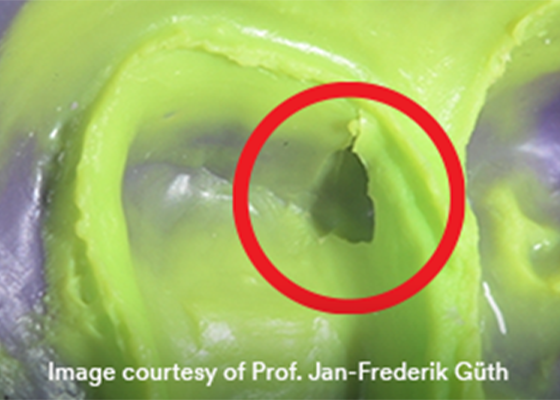Which substance is not one of the three hard substances of the tooth?
Brain of the Week – Chemistry


Voids in your impressions can lead to all kinds of troubles with your restoration. Finetune your technique and see how all’s well that starts well.
The process of fabricating an indirect restoration takes careful attention to detail at every step – because there are many opportunities for error. But one step stands above the rest as critical to success: impressioning. Here, first impressions matter most, and every step that follows hinges on an accurate impression.
In spite of the known importance of the impression, laboratory technicians are often asked to create flawless restorations based on flawed – or incomplete – information. Naturally, there is a hole in this logic. A technician cannot accurately add detail that the impression itself lacks. Only the dentist can provide the information necessary to error-free reproduction. How do you avoid the dreaded void? By using careful, proper technique to create a quality impression, which is the basis of a successful restoration.
Critical areas require exact duplication of detail, such as margins (especially subgingival) and the fine details of tooth preparations for crowns, veneers, onlays or inlays. It’s not easy to compensate for any voids or errors in the first impression. In fact, any flaws can be compounded throughout the rest of the procedure.
Gingival displacement and accurate impressioning still pose some of the greatest challenges in dentistry, despite the use of modern impressioning materials. Today’s materials may be more forgiving than their predecessors, but they can’t fully compensate for shortcomings in the procedure. A recent evaluation conducted within a commercial dental laboratory determined that 86% of crown-and-bridge impressions contained at least one detectable error and 55% contained a critical error related to the finish line.1
Dental practitioners would be well-advised to take greater care to evaluate the quality of their own impressions, rather than passing over minor mistakes – which could be magnified later in the procedure. Soft and hard tissue anatomy, gingival displacement, moisture management and the behavior of impressioning materials are all part of the equation. It’s time to see how a few simple refinements in your technique could add up to greater improvements in your impressions and final restorations.
So how can clinicians take a better impression the first time? The answers to that question are as many and varied as the causes of distortions and errors. However, by starting with identifying the precise issue with your impression and backtracking to its cause, you can get a better idea of how to move forward. Here are a few top tips for remediating common issues with technique, material or both:
Issue: Voids on margin and preparation
Causes:
Solutions:

Getting a thorough, high-quality impression can help save you time and bring you one step closer to restorative success – but it means being detail-oriented yourself. However, by taking the time to review your technique, your materials and common procedure pitfalls, you can avoid voids – and make a better first impression.
Want to learn more about common impressioning problems? Download this troubleshooting guide to help identify potential causes and solutions, and to learn the 10 Golden Rules for perfect impressions.

Brain of the Week – Chemistry

Brain of the Week – Fun Facts

Brain of the Week – Estimate